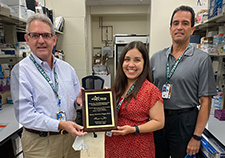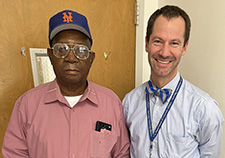Office of Research & Development |
 |


Height may be an unrecognized but biologically important and unchangeable risk factor for several common health conditions, according to an MVP study. (Photo for illustrative purposes only. ©Getty Images)
June 2, 2022
By Tristan Horrom
VA Research Communications

VA Study Documents Health Risks for Burn Pit Exposures

VA center training the next generation of researchers in blood clots and inflammation

Could cholesterol medicine reduce dementia risk in seniors?

VA investigator brings diversity into autoimmune disease research

Veterans help find new cancer treatments
A large genetic study by the VA Million Veteran Program (MVP) has found a person's height may affect their risk for several common health conditions in adulthood. Significant findings include a link between height and lower risk of coronary heart disease, and a link between height and higher risk for peripheral neuropathy and circulatory disorders.
The results appeared in the June 2, 2022, issue of the journal PLOS Genetics.
Dr. Sridharan Raghavan from the VA Eastern Colorado Health Care System, who led the study, described the results as “a significant contribution to understanding how height is related to clinical conditions from an epidemiologic perspective.” More research is needed before the findings might lead to changes in clinical care, says Raghavan. However, the results highlight the association between height and clinical conditions that impact the lives of Veterans, he explains. “The broad scope of our study yielded a catalog of clinical conditions associated with genetically predicted height. In other words, these are conditions for which height might be a risk factor, or protective factor, irrespective of other environmental conditions that also could impact height and health.”
Height is not typically considered a risk factor for diseases. But past research has shown correlations between how tall someone is and their likelihood of experiencing a number of health conditions. What isn’t well understood is whether this correlation has a biological basis or is due to other factors.
How tall someone grows to be as an adult is partly due to genes inherited from their parents. But environmental factors like nutrition, socioeconomic status, and demographics (for example, age or gender) also play a part in determining eventual height. This is why determining a connection between height and disease risk can be difficult.
To explore this connection, VA researchers looked at genetic and medical data from more than 280,000 Veterans enrolled in MVP. They compared these data to a list of 3,290 genetic variants associated with height from a recent genome analysis.
They found that risk levels of 127 different medical conditions can be linked to genetically predicted height in white patients. Since Black patients are less well-represented in genetic studies, fewer data are available on this population. But in this analysis, the medical traits associated with height were generally consistent across Black and white patients. About 21% of Veterans in the MVP study were Black. At least 48 of the links identified in white patients also held true for Black patients. All of the most significant findings—height being linked to lower risk of coronary heart disease and higher risk of atrial fibrillation, peripheral neuropathy, and circulatory disorders—were found in both Black and white participants, according to the researchers.
Overall, genetically predicted height was linked to both lower and higher disease risk, depending on the condition. Being tall appears to protect people from cardiovascular problems. The study linked being taller to lower risk of high blood pressure, high cholesterol, and coronary heart disease. But risk of atrial fibrillation was higher in taller participants. These connections have been shown before in previous research.
Conversely, being tall may increase the risk of the majority of non-cardiovascular conditions considered in the study. This was especially true of peripheral neuropathy and circulatory disorders involving the veins.
Peripheral neuropathy is damage to the nerves outside the brain and spinal cord, particularly in the limbs. Prior studies have linked height with slower nerve conduction and nerve problems. The MVP study confirms this link using genetic tools to suggest a higher risk of nerve problems in tall people.
The researchers linked genetically predicted height to conditions such as erectile dysfunction and urinary retention, both of which are associated with neuropathy.
Raghavan called the findings on peripheral neuropathy “particularly interesting.” He discussed this finding with clinical colleagues who often see patients with peripheral neuropathy. Raghavan’s colleagues confirmed that tall people often show the worst neuropathy, but they weren’t aware of other studies describing this association.
Conditions such as cellulitis, skin abscesses, chronic leg ulcers, and osteomyelitis were linked to height as well. Being tall also appears to raise the risk of circulatory conditions such as varicose veins and thrombosis—blood clots in veins.
Height also may increase the risk of other conditions not connected to neuropathy or circulation. Toe and foot deformities, conditions that could be caused by increased weight bearing of tall people, were more common in people whose genetics predicted they would be tall.
The study also showed height increases the risk of asthma and non-specific nerve disorders in women but not men.
Taken together, the results suggest that height may be an unrecognized but biologically important and unchangeable risk factor for several common conditions, particularly those that affect the extremities, according to the researchers. It may be useful to consider a person’s height when assessing risk and disease surveillance, they say.
More work is needed before this research can be translated into clinical care, says Raghavan. “I think our findings are a first step toward disease risk assessment in that we identify conditions for which height might truly be a risk factor,” he explains. “Future work will have to evaluate whether incorporating height into disease risk assessments can inform strategies to modify other risk factors for specific conditions.”
Future work will also focus on the potential mechanisms that tie height to these health conditions.
Researchers from multiple VA health care centers participated in the study, including, but not limited to, Dr. Tim Assimes from VA Palo Alto Health Care System; Dr. Yan Sun from the Atlanta VA Medical Center; and Dr. Chris O’Donnell, one of the national leaders of MVP, previously with the VA Boston Healthcare System and now with Novartis.
MVP is a national research program to learn how genes, lifestyle, and military exposures affect health and illness. Since launching in 2011, over 885,000 Veterans have joined MVP, making it one of the world’s largest programs on genetics and health.
Raghavan explains that studies such as this would not be possible without MVP. “MVP is extremely important for these types of studies,” he said. “By linking clinical data with genetic data, we can study clinical outcomes that are not commonly collected in other types of observational cohort data. For example, some of the stronger associations in our study—with peripheral neuropathy, venous insufficiency, osteomyelitis, foot ulcers—would not be collected routinely in lots of other data that include genetics. This linkage is helpful for research and for translating research findings back to clinical care.”
Beyond its sheer number of participants, MVP also allows for previously impossible research because of participation of Veterans from many different groups across the nation. “The other important contribution of MVP is its diversity,” explained Raghavan. “While the majority of participants are white, there are large numbers of Black and Hispanic participants, who have been underrepresented in genetic studies in the past.”
To learn more about MVP, visit mvp.va.gov.
VA Research Currents archives || Sign up for VA Research updates